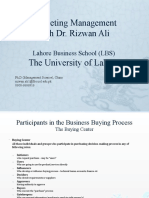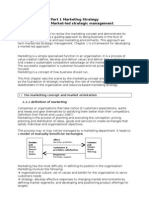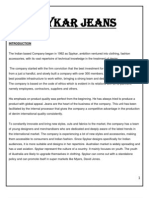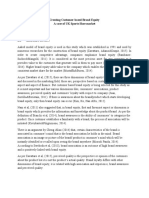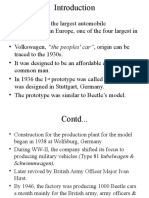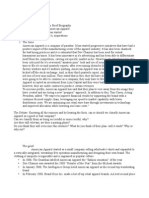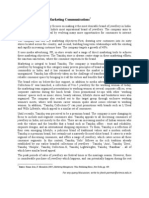Case Study #7: Gillette 27 July 2013 Case Analysis Prepared by Group #5
Case Study #7: Gillette 27 July 2013 Case Analysis Prepared by Group #5
Uploaded by
Liz EspinosaCopyright:
Available Formats
Case Study #7: Gillette 27 July 2013 Case Analysis Prepared by Group #5
Case Study #7: Gillette 27 July 2013 Case Analysis Prepared by Group #5
Uploaded by
Liz EspinosaOriginal Description:
Original Title
Copyright
Available Formats
Share this document
Did you find this document useful?
Is this content inappropriate?
Copyright:
Available Formats
Case Study #7: Gillette 27 July 2013 Case Analysis Prepared by Group #5
Case Study #7: Gillette 27 July 2013 Case Analysis Prepared by Group #5
Uploaded by
Liz EspinosaCopyright:
Available Formats
Case Study #7: Gillette Case Analysis Prepared by Group #5: Espinosa, Melissa Katherine Francisco, Marvin Importante,
Marlyn
27 July 2013
Magtibay, Roxanne Nito, Orenz Rosapapan,
Jennifer
I.
Synthesis
Gillette manufactured and sold a product invented by its founder: the safety razor shaving system. The company expanded its business over the years, particularly its international sales operations. It also acquired the following: Toni (maker of womens hair home permanent kits), Paper Mate, Liquid Paper, and Cricket lighters. Although these acquisitions were eventually sold by Gillette, additional acquisitions were made in the succeeding decades, such as Oral B, Braun, and Duracell. Razors and blades remained its top earners. Gillette experienced rapid growth from 1997-2000, largely due to the continuous increase of its international markets share. However, the company suffered declining market shares, stagnant sales, and reduced profits in the succeeding years. This was worsened by the plateauing North American and European markets, as well as the recession that hit Asia and South America. In trying to meet sales targets, Gillette resorted to trade loading, which retailers took full advantage of. Unrealistic targets also contributed to the decline of Gillette, since the company consistently failed to hit these goals. After a century of being managed by CEOs who had no professional experiences outside Gillette, the board of directors decided to hire Jim Kilts, an outsider responsible for Nabiscos successful turnaround. Kilts was expected to break Gillettes non -receptive culture in order to steer the company toward a much-needed organizational change. II. Point of View
The case is analyzed from Jim Kilts point of view. III. Statement of the Problem
How will Gillette effectively cope with organizational changes to turn around its financial performance and increase its market share for all products? IV. Statement of the Objectives
1. To reorganize the company structure that the whole organization will support and adopt. 2. To improve sales revenue and market share globally and locally. 3. To plan and allocate resources and adjust expenditures accordingly to focus on the companys growth. 4. To find means and ways wherein company leaders and employees can work together in achieving their shared vision, new goals, and objectives for the company. V. Areas for Consideration and Assumption Strengths 1. Historically a top player in the consumer product market in North America and Europe; it also leading market shares in all core products and high margins compared to competitors. 2. Reputable in manufacturing high quality and innovative products. 3. Possesses broad distribution network all over the world. 4. Strong management foundation built by leaders who have worked for the company. Weaknesses 1. Stagnant sales that resulted to declining profits, market shares and stock price. 2. The practice of trade loading was continued as a desperate measure to meet sales targets that lead to high sales only at the end of each quarter. 3. Very conservative culture that rejected change. 4. No observation done on customers and competitors to avoid giving service levels below industry standards. 5. High SG & A due to compensation given that was not based on performance but on tradition.
VI.
Theoretical / Conceptual Framework
The Michael Beers Bottom-Up Change Model Approach is adapted for this case since Gillette has a strong culture that has resisted several changes in the organization. This framework is also relevant since it will help foster participation among employees, which can create long-term organizational capability and economic value for stakeholders. Thus, this can translate to the development of corporate culture and human capability through
individual and organizational learning. This is done through the process of obtaining feedback, reflecting, and having a dynamic system. On the other hand, John Kotters Top-Down Change Model Approach is also applicable for Gillettes case. This approach focuses on maximizing the shareholders value and is usually done with drastic restructuring. Jim Kilts recognized the need for change when investigating on the companys performance. He ultimately mus t be able to establish urgency for transformation to avoid sales and profit from declining even further.
Kotter (top-down)
Beer (bottom-up)
VII.
Alternative Courses of Action (ACA)
ACA 1: Retain the existing organizational structure, culture, and processes. Pros No adjustments will be done in the organization and employees can continue with operations without disruptions. No extra effort on the part of the management. Cons Continuous decline of the company sales and market share. Changing internal systems of the company such as culture, work behavior, and structure are time consuming and may divide Kilts attention in turning around the
company financially. ACA 2: Adapt Kotter (top-down)/Mainstream approach in instigating organizational change. Pros Defined and clear direction for the company since the message will come from the management. Prompt implementation of change needed. Cons Employees will possibly be resistant to change. Possible drastic restructuring. Will likely lead to a number of employees leaving the company.
ACA 3: Adapt Beer (bottom-up)/Multistream approach in bringing organizational change Pros Employees will feel involved in the whole process by building trust and encouraging participation, which could make employees receptive to change. Customer feedback and competitors performance are considered in adjustments that will be made. Cons Slower implementation of change. Undefined and unclear direction for the company.
ACA 4: Apply combined Kotter and Beer approaches for organizational change Pros Focused both on the organizations structure/system and culture which can boost both profit and productivity at the same time. Definite new direction will be set while engaging the all the Cons Challenge to balance two different approaches, as change should come from both sides Changes might confuse the employees.
employees. VIII. Recommendation and Implementation
The groups recommendation is to apply both change model approaches -- top-down and bottom-up -- in order to maximize both stockholder value and organizational capabilities. This will also ensure that while the management sets the final direction of the company, the employees are involved in the process and their input are valued by the management. For the structural change, a shift from Matrix structure to Divisional structure should be done. The structure will work well in their new direction because it allows a team to focus on a single product or service. This will also empower the employees by effectively cultivating teamwork and communication, which would ultimately foster trust from and obtain commitment from all stakeholders. It will lead both to higher morale and a better knowledge of the division. It is an opportunity for employees to deeply understand their customer and develop customer service activities.
Before joining the company, Kilts is already familiar with the companys background and has identified the problems. On his day one, he should set a meeting with the heads and VIPs of the company. They will discuss the changes and new strategic plan of the company to increase its sale, to become a customer centric, manage the inventory and to stop trade loading to help reduce the cost.
The new direction should be ready to be released on his first week, which will also be filled with a series of meetings. Then, the second week will focus on polishing the new objectives and goals, including the new and well-defined KRA of employees. The HR department will organize a kick-off event in the third week to disseminate the changes to all stakeholders. In addition, a new organizational chart, criteria for stakeholders performance appraisal and incentive plans to reward deserving employees will also be released.
Kilts can set up a new team to address the issue of declining market share and profits. The initial planning will focus on evaluating existing product lines according to the following aspects: Product, Price, Place, Promotion, People. Another agenda will be revisiting and assessing current targets and goals, specifically if they are SMART. Marketing and strategic assessments can be made using a Value Map, which explores the way customer value and the price/benefit tradeoff work in real markets for a given segment .
IX.
Learning Insights
Organizational change involves substantial modification of existing trends, people, technology, structures, and perspectives. In order for a company to survive, it must adapt to external factors. This can be done through continuous improvement and holistic development based on shared values, trust, and participation. Another insight is that an organized structure will provide clear roles and KRA for the employees and help avoid overlapping responsibilities. Appraisal also plays an important
role in eliciting full employee commitment. Managers can also offer performance-based awards, which will motivate employees to work harder and think outside the box. Change is inevitable, and in an organizational change, the role of the manager is vital. In the Mainstream Approach, top managers make the crucial decisions, specifically in planning and implementing a smooth transition. On the other hand, the Multistream Approach is bottom-up, with emphasis given on the detailed process of change, as well as a broader range of reorganization issues.
You might also like
- Sanet - St-Surveying and Geomatics Engineering Principles Technologies and ApplicationsDocument579 pagesSanet - St-Surveying and Geomatics Engineering Principles Technologies and ApplicationsHafidhz amrullah100% (2)
- Sales Management - 2e - Chapter 1Document34 pagesSales Management - 2e - Chapter 1zeeNo ratings yet
- Royal Enfield: Revival of A Cult Brand: Answer The Following QuestionsDocument1 pageRoyal Enfield: Revival of A Cult Brand: Answer The Following Questionssai priya tirumalasettyNo ratings yet
- Nike Dri-FIT Market Research: Proposal ForDocument35 pagesNike Dri-FIT Market Research: Proposal ForNikhilKhemka0% (1)
- Questions For CasesDocument2 pagesQuestions For Casesshivam choudhary25% (4)
- Amul Case MRDocument1 pageAmul Case MRbhartic0% (2)
- NIKE Brand AuditDocument31 pagesNIKE Brand Auditsaivijay2018No ratings yet
- Brand Report Card Exercise - SumitabhDocument6 pagesBrand Report Card Exercise - SumitabhSamihan TammewarNo ratings yet
- XINE249 BBM Sample SyllabusDocument0 pagesXINE249 BBM Sample SyllabuslilbouyinNo ratings yet
- Strategic Managment AssignmentDocument6 pagesStrategic Managment Assignmentsharad jainNo ratings yet
- Case - Retaining Profits at Apna BazaarDocument3 pagesCase - Retaining Profits at Apna BazaarSaransh ThahraniNo ratings yet
- Hindustan Unilever Sales OrganizationstructureDocument5 pagesHindustan Unilever Sales Organizationstructuresharma_140425015No ratings yet
- CRM SyllabusDocument1 pageCRM SyllabusNitu KumariNo ratings yet
- How TITAN Watches Changed Consumers Perception About Wrist WatchesDocument16 pagesHow TITAN Watches Changed Consumers Perception About Wrist WatchessiddiquiajazNo ratings yet
- Study of Retail Mix at Various Outlets of Reliance FreshDocument7 pagesStudy of Retail Mix at Various Outlets of Reliance FreshUday Dakre0% (1)
- Unit 7Document27 pagesUnit 7Pawan SinghNo ratings yet
- The Great Battle of Instant Noodles in IndiaDocument18 pagesThe Great Battle of Instant Noodles in Indiakgupta0311No ratings yet
- Service Marketing: HDFCDocument13 pagesService Marketing: HDFCAnkit JainNo ratings yet
- Wheel of RetailingDocument2 pagesWheel of Retailingakash bathamNo ratings yet
- International Marketing Research (DR - Meenakshi SharmaDocument21 pagesInternational Marketing Research (DR - Meenakshi Sharmashweta shuklaNo ratings yet
- Project Sales Promotion (Kanwardeep)Document39 pagesProject Sales Promotion (Kanwardeep)Shubham BhasinNo ratings yet
- Principles of Marketing Eighth Edition Philip Kotler and Gary ArmstrongDocument16 pagesPrinciples of Marketing Eighth Edition Philip Kotler and Gary ArmstrongsiewspahNo ratings yet
- Break Free From The Product Life CycleDocument13 pagesBreak Free From The Product Life CycleTanu GuptaNo ratings yet
- Competition and Product StrategyDocument32 pagesCompetition and Product StrategyMohammed Marfatiya100% (1)
- The Buying CenterDocument6 pagesThe Buying CenterMoona MalikNo ratings yet
- SfaDocument16 pagesSfabj3326No ratings yet
- Market-Led Strategic ManagementDocument6 pagesMarket-Led Strategic ManagementDietmar Lengauer0% (2)
- CRMDocument37 pagesCRMAkhil AwasthiNo ratings yet
- Bata Case StudyDocument3 pagesBata Case StudyNina_C_ALNo ratings yet
- Parallel Channel EnvironmentDocument2 pagesParallel Channel EnvironmentSaumya SharmaNo ratings yet
- Fordâ ™s European Organization Changes StrategyDocument12 pagesFordâ ™s European Organization Changes StrategySanit Sadhu100% (1)
- Spykar JeansDocument6 pagesSpykar Jeansshjvd72100% (1)
- Learning Outcome: Evaluator's Comments (For Instructor's Use Only)Document5 pagesLearning Outcome: Evaluator's Comments (For Instructor's Use Only)Neel PrasantNo ratings yet
- Customer Based Brand EquityDocument3 pagesCustomer Based Brand EquitytomalNo ratings yet
- SDM Assignment: BY-Group 4Document11 pagesSDM Assignment: BY-Group 4bibek mishraNo ratings yet
- Brand PersonalityDocument22 pagesBrand Personalitynitesh kumarNo ratings yet
- Volkswagen IntroductionDocument4 pagesVolkswagen IntroductionShyam RajNo ratings yet
- Brand Repositioning: If A Brand Does Not Reposition at The Right Time, It May Not Get A Second ChanceDocument47 pagesBrand Repositioning: If A Brand Does Not Reposition at The Right Time, It May Not Get A Second Chanceaftabssm0% (1)
- Louis PhilippeDocument2 pagesLouis PhilippeSanjeev Sharma100% (1)
- BrandingDocument88 pagesBrandingMahmoud WardNo ratings yet
- American Apparel Case Study 2Document2 pagesAmerican Apparel Case Study 2aamarketing0% (1)
- Final Report - 8287 (Marketing)Document33 pagesFinal Report - 8287 (Marketing)Hussnain Waheed BhattiNo ratings yet
- Sales and Distribution Management 2e Tapan K. Panda Sunil SahadevDocument11 pagesSales and Distribution Management 2e Tapan K. Panda Sunil SahadevKartik KaushikNo ratings yet
- Marketing Research SlidesDocument16 pagesMarketing Research SlidesMegha GaurNo ratings yet
- Vivel - Brand EquityDocument13 pagesVivel - Brand EquityShivkarVishalNo ratings yet
- A Term Paper On Itc LTDDocument32 pagesA Term Paper On Itc LTDDeepak KumarNo ratings yet
- Service Marketing-Supernova Case AnalysisDocument5 pagesService Marketing-Supernova Case AnalysisDorisFuentesNo ratings yet
- Sales OrganisationDocument8 pagesSales OrganisationGOKUL G100% (1)
- Lifebuoy Product Life CycleDocument43 pagesLifebuoy Product Life CycleAIS DSONo ratings yet
- Principles of Marketing Eighth Edition Philip Kotler and Gary ArmstrongDocument15 pagesPrinciples of Marketing Eighth Edition Philip Kotler and Gary ArmstrongFahim KhanNo ratings yet
- Effects of Visual MerchendisingDocument59 pagesEffects of Visual MerchendisingAshas N GNo ratings yet
- New Product Forecasting Using Structure AnalogiesDocument11 pagesNew Product Forecasting Using Structure AnalogiesBharathkumar YakkalaNo ratings yet
- JP Tanishq-IMCDocument2 pagesJP Tanishq-IMCAshish OmarNo ratings yet
- Lecture 10&11 SDM Unit III (Sales Budget) ER AMDocument10 pagesLecture 10&11 SDM Unit III (Sales Budget) ER AMArun MishraNo ratings yet
- Assignment (PMK1) - Philips Air Purifier CaseDocument5 pagesAssignment (PMK1) - Philips Air Purifier CaseSoham BanerjeeNo ratings yet
- Brand RepositioningDocument64 pagesBrand RepositioningAnonymous GuyNo ratings yet
- Online Case Study Challenge - LearnousDocument3 pagesOnline Case Study Challenge - Learnousvishesh jainNo ratings yet
- Nielsen SIP Final ReportDocument27 pagesNielsen SIP Final ReportRohit JoshiNo ratings yet
- Value Chain Management Capability A Complete Guide - 2020 EditionFrom EverandValue Chain Management Capability A Complete Guide - 2020 EditionNo ratings yet
- Samsung Mobile: Espinosa, Elbinias, FidelDocument13 pagesSamsung Mobile: Espinosa, Elbinias, FidelLiz EspinosaNo ratings yet
- Chapter 27 Management AccountingDocument19 pagesChapter 27 Management AccountingLiz Espinosa100% (1)
- TDD LTE Vs FDD LTEDocument10 pagesTDD LTE Vs FDD LTEppongsin2322100% (1)
- Biochemical Aspect of DiarrheaDocument17 pagesBiochemical Aspect of DiarrheaLiz Espinosa0% (1)
- Diarrhea Case - Cholera CombinedDocument90 pagesDiarrhea Case - Cholera CombinedLiz EspinosaNo ratings yet
- 11 Principles of HSDPADocument43 pages11 Principles of HSDPAguyvetNo ratings yet
- Session 4 - Verb TensesDocument35 pagesSession 4 - Verb TensesLiz EspinosaNo ratings yet
- MCWP 3-16 Fire Support Coordination in The Ground Combat ElementDocument260 pagesMCWP 3-16 Fire Support Coordination in The Ground Combat ElementRobert Edward HymesNo ratings yet
- Grease Stock Date:30-06-2020: SR.# Code Grease Name Remaing QTY Required QTY RemarksDocument1 pageGrease Stock Date:30-06-2020: SR.# Code Grease Name Remaing QTY Required QTY RemarksMuhammad Waqar AhsanNo ratings yet
- Respirator References: - 29 CFR 1910.134 - ANSI Z88.2-1992Document21 pagesRespirator References: - 29 CFR 1910.134 - ANSI Z88.2-1992benonNo ratings yet
- Science - Learning-Activity-Worksheets-8 PagesDocument8 pagesScience - Learning-Activity-Worksheets-8 PagesMaria AnnaNo ratings yet
- Analisis Gaya Bahasa Dalam Puisi Ada Tilgram TibaDocument16 pagesAnalisis Gaya Bahasa Dalam Puisi Ada Tilgram TibaBunga TasbihNo ratings yet
- Brochure Air Compressors XHP900 1070T1Document4 pagesBrochure Air Compressors XHP900 1070T1Ichou MohamedNo ratings yet
- Section A Section A Consists of 7 Questions (1-7), Each Question Carries 2 MarksDocument5 pagesSection A Section A Consists of 7 Questions (1-7), Each Question Carries 2 Marksavi jitNo ratings yet
- Alphabet Codes: Example: If Uytc Wave Then RMLCDocument3 pagesAlphabet Codes: Example: If Uytc Wave Then RMLCSach BansalNo ratings yet
- Practice Test 7. 01.6.2021. KeyDocument6 pagesPractice Test 7. 01.6.2021. KeyHien NguyenNo ratings yet
- urfutitDocument9 pagesurfutitviswaselvi09No ratings yet
- Use and Maintenance: 710 K - 712 K - 715 K - 720 KDocument65 pagesUse and Maintenance: 710 K - 712 K - 715 K - 720 KСвятослав ВороновNo ratings yet
- Kurikulum Program Studi S1 Teknik Sipil Fakultas Teknik TAHUN AJARAN 2019/2020Document10 pagesKurikulum Program Studi S1 Teknik Sipil Fakultas Teknik TAHUN AJARAN 2019/2020yanda adhaNo ratings yet
- AWS ResumeDocument2 pagesAWS Resumepritam.powerstarNo ratings yet
- Listado Precios MayoristaDocument452 pagesListado Precios MayoristaDANIEL FERNANDO PERDOMO ROMERONo ratings yet
- Chapter 5 f2Document82 pagesChapter 5 f2Nurul HusnaNo ratings yet
- CompareandcontrastsampleDocument2 pagesCompareandcontrastsamplebrightononyango18No ratings yet
- May 2010 PEC Preboard Exam (Answer)Document8 pagesMay 2010 PEC Preboard Exam (Answer)Gino DayoNo ratings yet
- War and Peace in The Borderlands of Myanmar Book Review - Final - RevisedDocument6 pagesWar and Peace in The Borderlands of Myanmar Book Review - Final - RevisedJaideep ChandaNo ratings yet
- Proficiency Expert Coursebook FullDocument209 pagesProficiency Expert Coursebook FullPiotr Kapica100% (2)
- Hexagonal Roman EcatalogDocument15 pagesHexagonal Roman EcatalogFatmawatiNo ratings yet
- Best Graphics Cards Comparison 2024Document2 pagesBest Graphics Cards Comparison 2024lucianandreibedruleaNo ratings yet
- Alexander Lowen - The Language of The Body (Physical Dynamics of Character Structure) (1958, Psychology, Freud)Document404 pagesAlexander Lowen - The Language of The Body (Physical Dynamics of Character Structure) (1958, Psychology, Freud)Barbara Kubiec75% (4)
- QM-27 1Document4 pagesQM-27 1Rizky HarisandiNo ratings yet
- Rws-Week 9Document3 pagesRws-Week 9Milcah Roselle CandaNo ratings yet
- Imperial College Extension ServicesDocument13 pagesImperial College Extension ServicesMyron TimtimNo ratings yet
- Huum Uku Paigaldus Ja Kasutusjuhend 2020Document100 pagesHuum Uku Paigaldus Ja Kasutusjuhend 2020Влад777 СмородинNo ratings yet
- 27.0 - Confined Spaces v3.1 English - UpdatedDocument14 pages27.0 - Confined Spaces v3.1 English - UpdatedjbdejhiuhwNo ratings yet
- Module 9Document18 pagesModule 9Ritesh GuleriaNo ratings yet
- ACL 3200 Flare Stack/Incinerator Ignition SystemDocument1 pageACL 3200 Flare Stack/Incinerator Ignition SystemRadu ScafariuNo ratings yet
























